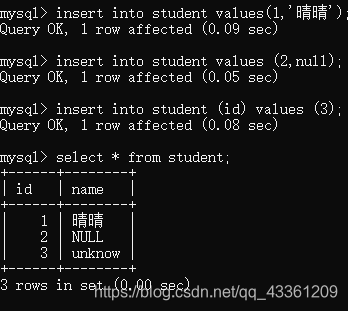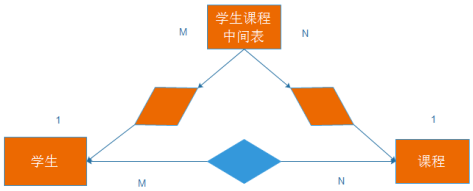热门标签
热门文章
- 1为android编译python的图像库pillow_python pil android
- 2逻辑斯蒂回归(Logistic Regression) | 算法实现_logistic regression算法的实现步骤
- 3论文学习——基于改进Bi-LSTM和XGBoost的电力负荷组合预测方法_lstm+xgboos
- 4【正点原子Linux连载】第三十二章 Linux RS232/485驱动实验 摘自【正点原子】ATK-DLRK3568嵌入式Linux驱动开发指南
- 5User class threw exception: org.apache.spark.SparkException: Task not serializable问题解决_diagnostics: user class threw exception: org.apach
- 6【超万字详细Mysql的基本语法之增删查改】_mysql用法
- 7大数据之ZooKeeper介绍_zookeeper集群一般用来实现大数据存储
- 8【蓝牙】BluetoothAdapter详解
- 9国密算法SM2 的JAVA实现(基于BC实现)_java sm2
- 10Vue环境搭建_vue环境安装与配置
当前位置: article > 正文
【数据库】表的增删改查(进阶)_数据库表的增删改
作者:知新_RL | 2024-04-25 03:39:31
赞
踩
数据库表的增删改
表的增删改查(基础操作): https://blog.csdn.net/qq_43361209/article/details/105749745
1.数据库约束
| 约束类型 | 说明 | 示例 |
|---|---|---|
| NULL约束 | 使用NOT NULL指定列不为空 | id int not null |
| UNIQUE唯一约束 | 指定列为唯一的、不重复的值 | id int unique |
| DEFAULT默认值约束 | 指定列为空时的默认值 | age int default 20 |
| 主键约束 | NOT NULL 和 UNIQUE 的结合,表中唯一标识 | id int primary key |
| 外键约束 | 关联其他表的主键或唯一键 | foreign key(字段名) references 主键表(列) |
| CHECK约束 | 保证列中的值符合指定的条件 | check (sex =‘男’ or sex=‘女’) |
1.1 NULL约束
-- 创建表时,可以指定某列不为空
create table student(
id int not null,
name varchar(20),
main varchar(30)
);
- 1
- 2
- 3
- 4
- 5
- 6
- 7
插入id为空时报错:

1.2 UNIQUE:唯一约束
-- 创建表时,可以指定某列值唯一
create table student(
id int unique,
name varchar(20)
);
- 1
- 2
- 3
- 4
- 5
- 6
插入重复id报错:

1.3 DEFAULT:默认值约束
-- 创建表时,可以指定某列的默认值
create table student(
id int,
name varchar(20) default 'unknow'
);
- 1
- 2
- 3
- 4
- 5
- 6
指定插入数据时,只插入id,name默认值 unknow :

1.4 PRIMARY KEY:主键约束
-- 创建表时,可以指定主键
create table student(
id int primary key,
name varchar(20)
);
-- 对于整数类型的主键,常配搭自增长auto_increment来使用。
id INT PRIMARY KEY auto_increment
- 1
- 2
- 3
- 4
- 5
- 6
- 7
- 8
主键不能为空,不能重复,否则报错:

1.5 FOREIGN KEY:外键约束
外键用于关联其他表的主键或唯一键,语法:
foreign key (字段名) references 主表(列)
- 1
-- 创建班级表class,id为主键 create table class( id int primary key auto_increment, name varchar(20) ); -- 创建学生表student,一个学生对应一个班级,一个班级对应多个学生 -- 使用id为主键,classes_id为外键,关联班级表id create table student( id int primary key, class_id int, foreign key (class_id) references class (id) ); -- 此时操作 student 中的 class_id,会受到 class 表内容的制约 -- 插入 student 表的 class_id 的值必须在 class 表中存在 -- 若插入的 class_id 字段的值在 class 表中不存在,插入失败,报错 测试: -- 班级表插入数据 insert into class (name) values ("A班"); insert into class (name) values ("B班"); -- 学生表插入数据 insert into student values(001,3); -- 报错 插入失败 ERROR 1452 (23000): Cannot add or update a child row: a foreign key constraint fails (`test1`.`student`, CONSTRAINT `student_ibfk_1` FOREIGN KEY (`class_id`) REFERENCES `class` (`id`)) insert into student values(001,1); -- 插入成功 insert into student values(002,1); -- 插入成功 insert into student values(003,2); -- 插入成功
- 1
- 2
- 3
- 4
- 5
- 6
- 7
- 8
- 9
- 10
- 11
- 12
- 13
- 14
- 15
- 16
- 17
- 18
- 19
- 20
- 21
- 22
- 23
- 24
- 25
- 26
- 27
- 28
注意:
对带有外键的表进行插入/修改时,mysql会自动去关联表中查找插入/修改的值是否存在,查找完毕才会真正执行插入/修改操作。
带来的影响是加强了数据的效验(提高了完整性),但降低了效率。
1.6 CHECK约束
-- -- 创建表时,可以保证列中的值符合指定条件
create table test_user (
id int,
name varchar(20),
sex varchar(1),
check (sex ='男' or sex='女')
);
- 1
- 2
- 3
- 4
- 5
- 6
- 7
- 8
插入非指定条件,报错:

2.表的设计
三大范式:一对一、一对多、多对多
2.1 一对一

2.2 一对多

2.3 多对多

案例:
-- 创建课程表 DROP TABLE IF EXISTS course; CREATE TABLE course ( id INT PRIMARY KEY auto_increment, name VARCHAR(20) ); -- 创建课程学生中间表:考试成绩表 DROP TABLE IF EXISTS score; CREATE TABLE score ( id INT PRIMARY KEY auto_increment, score DECIMAL(3, 1), student_id int, course_id int, FOREIGN KEY (student_id) REFERENCES student(id), FOREIGN KEY (course_id) REFERENCES course(id) );
- 1
- 2
- 3
- 4
- 5
- 6
- 7
- 8
- 9
- 10
- 11
- 12
- 13
- 14
- 15
- 16
- 17
3.新增:插入查询结果
语法:
-- 插入一个 select 返回的结果
INSERT INTO table_name [(column [, column ...])] SELECT ...
- 1
- 2
案例:
create table s1 (id int,name varchar(20),sex varchar(1));
insert into s1 values
(1,'黎明','男'),
(2,'孙悟空','男'),
(3,'胡歌','男');
create table s2 (id int,name_s2 varchar(20),sex varchar(1));
-- 将 s1 中数据全部插入 s2
insert into s2 select * from s1;
create table s3 (name varchar(20),sex varchar(1));
-- 将 s1 中姓名和性别数据全部插入 s3
insert into s3 (name,sex) select name,sex from s1;
- 1
- 2
- 3
- 4
- 5
- 6
- 7
- 8
- 9
- 10
- 11
- 12
- 13


4.查询
聚合查询和联合查询:https://blog.csdn.net/qq_43361209/article/details/105846871
MySQL中内连接,外连接等的区别

图片来源于网络,仅供学习使用,如有侵权立马删除!!!
声明:本文内容由网友自发贡献,不代表【wpsshop博客】立场,版权归原作者所有,本站不承担相应法律责任。如您发现有侵权的内容,请联系我们。转载请注明出处:https://www.wpsshop.cn/w/知新_RL/article/detail/483060?site
推荐阅读
相关标签



